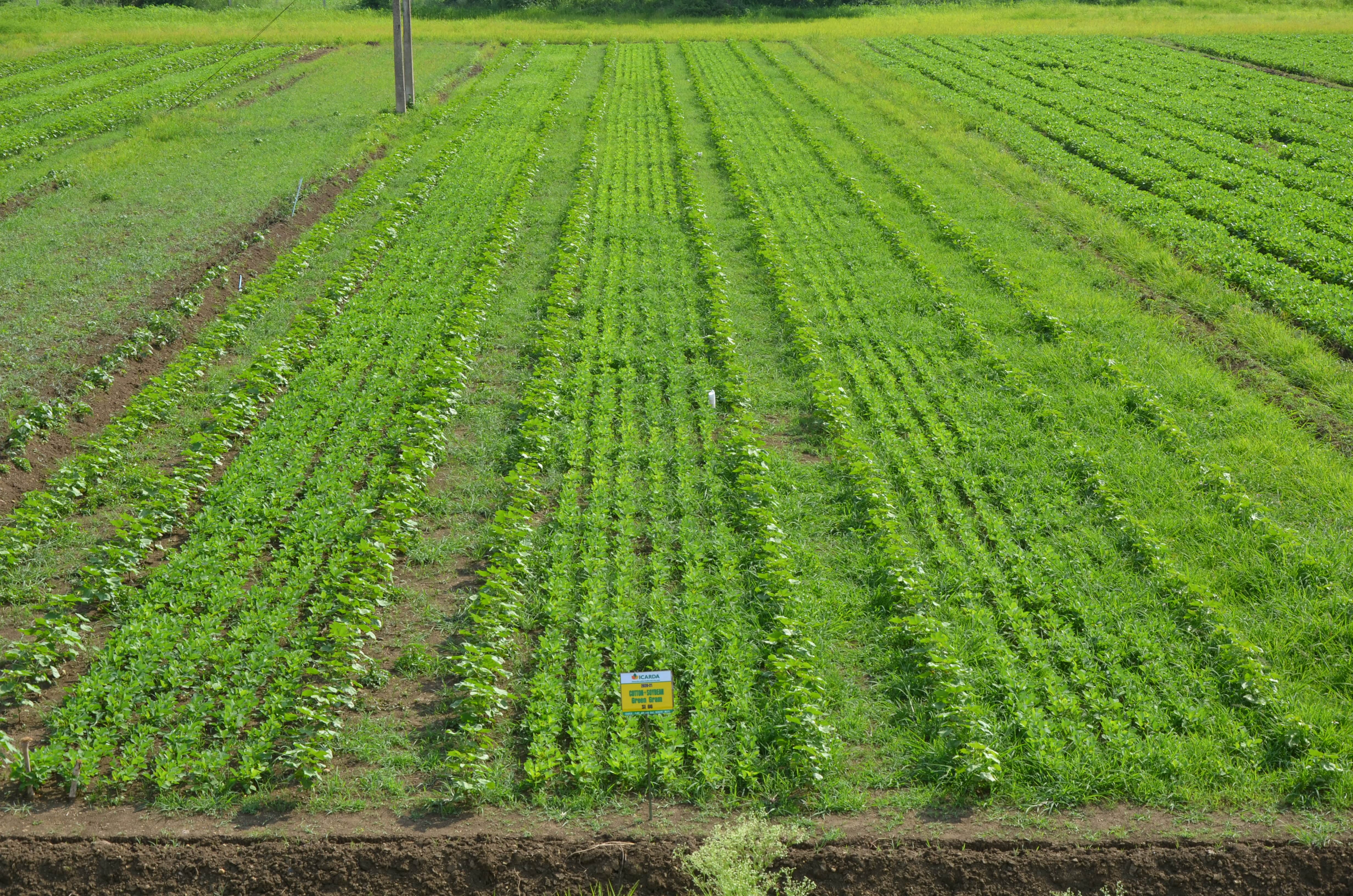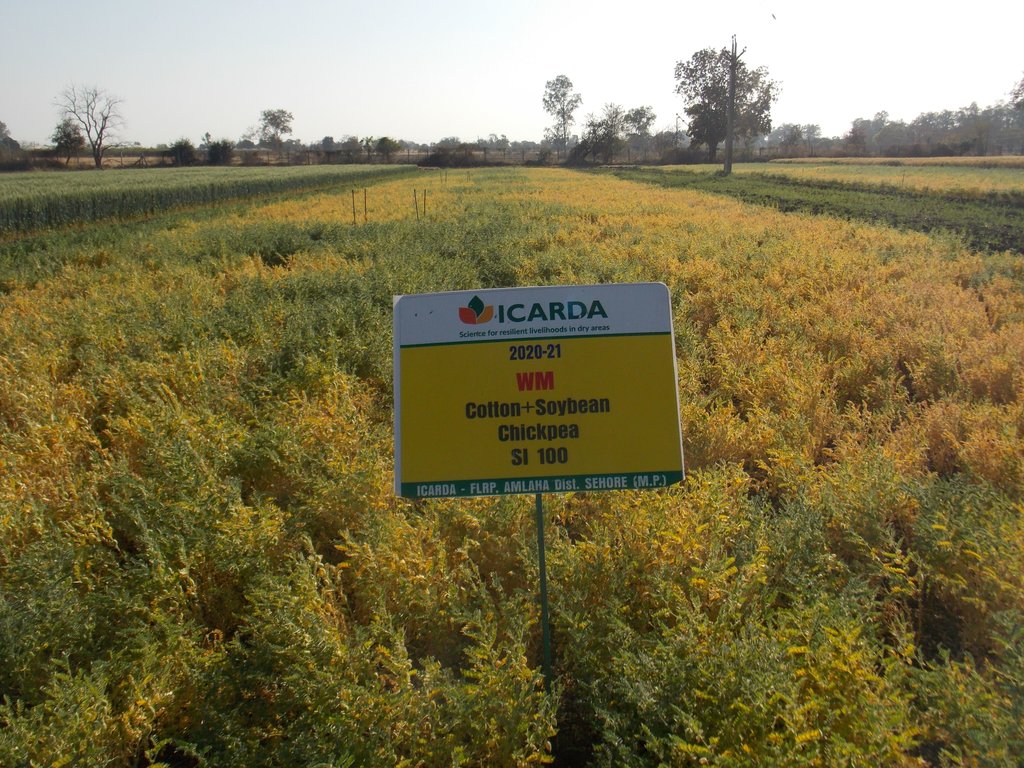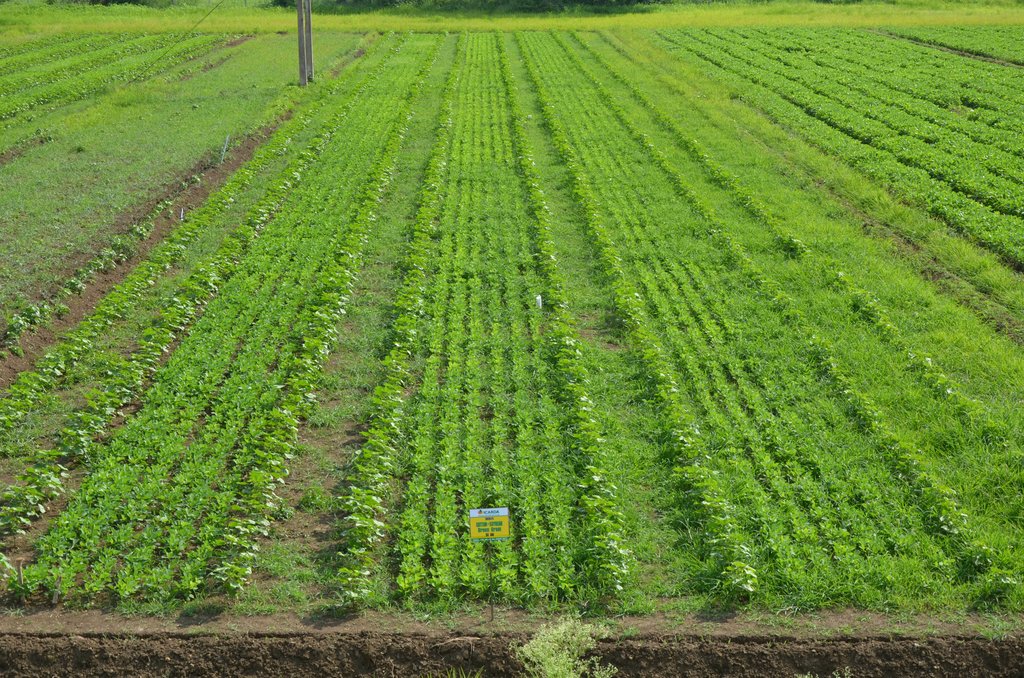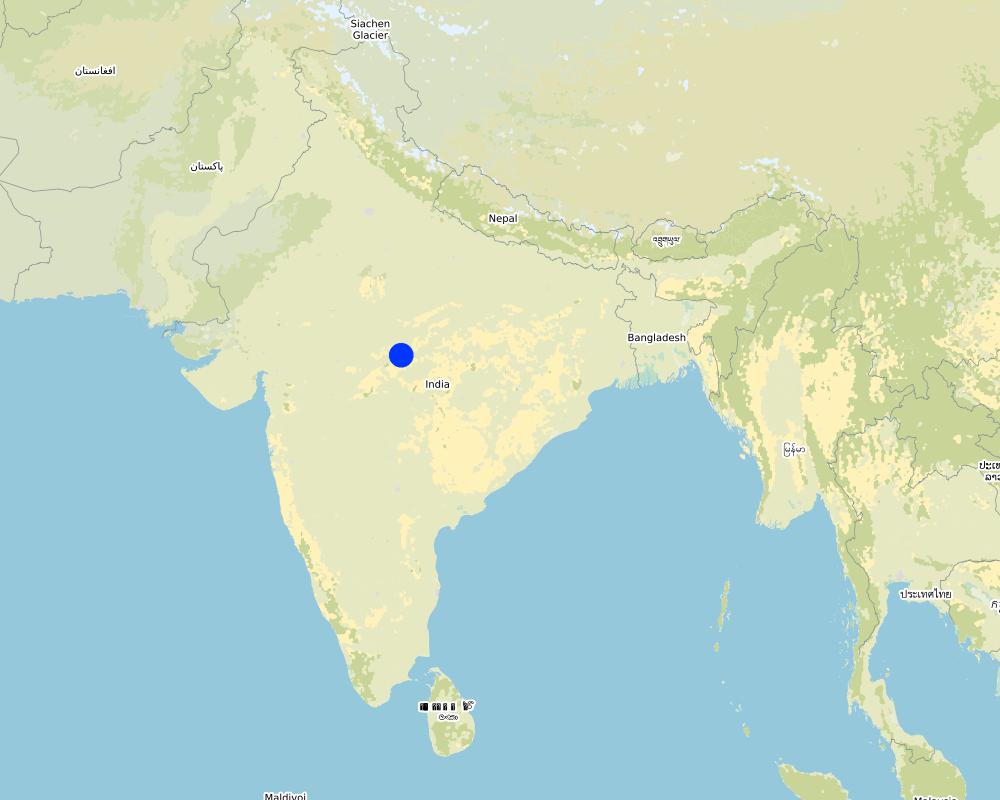Supplemental Irrigation in a Legume-Cotton Production System [印度]
- 创建:
- 更新:
- 编制者: Joren Verbist
- 编辑者: –
- 审查者: William Critchley, Rima Mekdaschi Studer
technologies_5820 - 印度
查看章节
全部展开 全部收起1. 一般信息
1.2 参与该技术评估和文件编制的资源人员和机构的联系方式
关键资源人
Research Team Leader - Soils, Waters and Agronomy:
Nangia Vinay
International Center of Agriculture Research in the Dry Areas (ICARDA)
摩洛哥
Research Associate Agronomy:
Sinha Rajni
International Center of Agriculture Research in the Dry Areas (ICARDA)
印度
有助于对技术进行记录/评估的项目名称(如相关)
ICARDA Institutional Knowledge Management Initiative有助于对技术进行记录/评估的机构名称(如相关)
International Center for Agricultural Research in the Dry Areas (ICARDA) - 黎巴嫩1.3 关于使用通过WOCAT记录的数据的条件
编制者和关键资源人员接受有关使用通过WOCAT记录数据的条件。:
是
1.4 所述技术的可持续性声明
这里所描述的技术在土地退化方面是否存在问题,导致无法被认为是一种可持续的土地管理技术?:
否
2. SLM技术的说明
2.1 技术简介
技术定义:
Supplemental Irrigation (SI) offers a solution for irregular rainfall, as it provides a limited amount of water to essentially rainfed crops consequently ensuring good plant growth. Furthermore, SI provides the opportunity for a more diverse production system such as a legume-cotton system in which chickpeas are cultivated as a winter crop, and soybean and cotton are inter-cropped in the summer.
2.2 技术的详细说明
说明:
The state of Madhya Pradesh (India) has an average annual rainfall of around 1170 mm. However, data shows a declining trend. It is characterized by a monsoon period from July to September. Winter is from December to January and the summer is from February to March. The rainfall is irregular, resulting in crop failures, land degradation, nutrient leaching and shortened growing seasons. This constrains the agricultural sector, upon which 74% of the population is either directly or indirectly dependent. 38% of the agricultural area is intensively/conventionally irrigated. The majority of the water is obtained from groundwater which has led to over-exploitation.
To sustainably improve the agricultural sector, the International Center for Agricultural Research in the Dry Areas (ICARDA) introduced Supplemental Irrigation (SI). This is a practice in which essentially rainfed crops are cultivated rather than more water demanding crops. SI ensures a sufficient amount of water as rainfall satisfies the majority of the crop water demand. Water availability is not sought in (fossil) groundwater extraction, thus avoiding over-exploitation, but rather through rainwater harvesting (RWH), using the rainfall optimally. In addition, SI prolongs the growing season and enables more diverse farming systems by crop rotation and inter-cropping.
In 2018, a reservoir was constructed, with a 900,000 litres capacity. Every rainy season groundwater rises to the surface, indicating that the soil is fully saturated. The reservoir is filled by pumping the surface water from shallow wells. This is considered sustainable RWH as it assumed the pumped water is solely rainwater. An additional benefit of this approach is that no large catchment area is required. The building of the reservoir consists of 1) excavating the soil; 2) stone pitching the excavation; 3) installing polysheet to avoid water losses through infiltration. The water from the reservoir is distributed over the field by a portable (wheeled) sprinkler irrigation system. Hence, pumping from the reservoir is required.
The water from the reservoir allows for crop rotation with a winter crop, namely chickpeas. This crop grows from November till March, outside of the rainy season. Without SI, chickpea yield is poor as farmers must wait until sufficient rain has fallen before sowing, limiting the growing period. SI can provide the necessary water for the chickpeas to germinate well, ensuring a sufficient growing period. The chickpeas are manually harvested in March. Besides increased income for the farmer, chickpeas also provide valuable soil improvement as the plant fixes atmospheric nitrogen in the soil.
In additional to crop rotation, SI and water harvesting allows for a more intensive cropping system in which cotton and soybean are intercropped. These crops are planted in June-July. The intercrop ratio is two rows of cotton and six rows of soybean. Soybean and cotton are respectively threshed and harvested in October. Consequently, the plants are grown mainly in the rainy season. Fertilizer (80 kg nitrogen, 100 kg phosphorus and 60 kg potassium per hectare) is applied directly after sowing, hence June-July. In the same period the field is manually weeded. Micro-Nutrients (a mixture of B, Zn, Mn) are applied if needed. On average, this corresponds to one kilogram per hectare. Mechanical pesticide application is done from July to August by a sprayer, consisting of herbicides, fungicides and insecticides.
The frequency and amount of irrigated water through SI is unpredictable as it compensates rainfall irregularity. Nevertheless, it is advised to irrigate less than the infiltration rate of the soil, to avoid deep percolation of water and nutrient leaching. That is, it is better to irrigate small doses multiple times. For this reason, sandy soils are unsuitable as they have relatively high infiltration rates and low water holding capacity. On average, one hectare of this particular production system is irrigated through sprinklers thrice by 250 cubic meters of harvested water.
A great advantage of SI is that it leads to a year-round income through a diversified production system with an additional winter crop. Farmers also value SI ensuring stable yields, thus making them less vulnerable to rainfall irregularities. Also, the diversified system protects the crops better against epidemics. And as there are legumes included in the system, the soil quality is improved, lowering the required amount of nitrogen fertilizer.
Nevertheless, SI has some weaknesses. For example, the implementation of SI is difficult for smallholder farmers as they lack the area for a reservoir. In addition, the initial costs are high, so adoption may be restrained by the lack of available funds, especially for smallholder farmer. This specific SI, by water harvesting (extracting shallow groundwater) is not suitable in areas of poor groundwater recharge. But the concept of SI can be applied. To conclude, where it is technically and financially feasible, SI allows for more intensive, diversified and stable production system under climate change induced risks, hence supplemental irrigation is an important technique to improve the livelihoods of farmers exposed to climate change.
2.3 技术照片
2.5 已应用该技术的、本评估所涵盖的国家/地区/地点
国家:
印度
区域/州/省:
Central India
有关地点的进一步说明:
Madhya Pradesh
具体说明该技术的分布:
- 均匀地分布在一个区域
如果不知道精确的区域,请注明大致覆盖的区域:
- < 0.1 平方千米(10 公顷)
技术现场是否位于永久保护区?:
否
Map
×2.6 实施日期
注明实施年份:
2018
2.7 技术介绍
详细说明该技术是如何引入的:
- 在实验/研究期间
- 通过项目/外部干预
3. SLM技术的分类
3.1 该技术的主要目的
- 改良生产
- 适应气候变化/极端天气及其影响
- 创造有益的经济影响
- 创造有益的社会影响
3.2 应用该技术的当前土地利用类型
同一土地单元内混合使用的土地::
否

农田
- 一年一作
年作 - 具体指明作物:
- 纤维作物 - 棉花
- 豆科牧草和豆类 - 豌豆
- 豆科牧草和豆类 - 大豆
每年的生长季节数:
- 2
采用间作制度了吗?:
是
如果是,说明哪些作物是间作的:
Cotton (1) and soybean (2) are intercropped in the rainy season
采用轮作制度了吗?:
是
如果是,请具体说明:
In the winter, chickpeas are cultivated.
3.3 由于技术的实施,土地使用是否发生了变化?
由于技术的实施,土地使用是否发生了变化?:
- 是(请在技术实施前填写以下有关土地利用的问题)

农田
- 一年一作
年作 - 具体指明作物:
- 豆科牧草和豆类 - 豌豆
- 豆科牧草和豆类 - 大豆
采用轮作制度了吗?:
是
3.4 供水
该技术所应用土地的供水:
- 混合雨水灌溉
3.5 该技术所属的SLM组
- 轮作制度(轮作、休耕、轮垦)
- 集水
- 灌溉管理(包括供水、排水)
3.6 包含该技术的可持续土地管理措施

农艺措施
- A1:植被和土壤覆盖层
- A3:土壤表面处理
A3:区分耕作制度:
A 3.1:免耕

植物措施

结构措施
- S5:大坝、集水斗、水池
- S7:集水/供水/灌溉设备

管理措施
- M2:改变管理/强度级别
3.7 该技术强调的主要土地退化类型

土壤水蚀
- Wt:表土流失/地表侵蚀

土壤风蚀
- Et:表土流失

化学性土壤退化
- Cs:盐化/碱化

物理性土壤退化
- Pw:水浸

生物性退化
- Bc:植被覆盖的减少
- Bq:数量/生物量减少

水质恶化
- Ha:干旱化
- Hs:地表水良变化
- Hg:地下水/含水层水位的变化
3.8 防止、减少或恢复土地退化
具体数量名该技术与土地退化有关的目标:
- 适应土地退化
4. 技术规范、实施活动、投入和成本
4.1 该技术的技术图纸
技术规范(与技术图纸相关):
The dimensions are :
-A: 46 meter
-B: 35 meter
-C: 29 meter
-D: 140 degrees
-E: 9 meter
-F: 3.8 meter
-G: 3.2 meter
The reservoir has a capacity of 9 000 cubic meter water. It is lined with 2847 square meter of polysheet to avoid water losses through infiltration.
技术规范(与技术图纸相关):
The dimension related to the Winter-crop Chickpeas (in cm):
Spacing between rows (A) = 30
Spacing between plants within rows (B) = 15
作者:
Joren Verbist
日期:
12/02/2021
技术规范(与技术图纸相关):
The dimensions related to the Soybean Cotton intercropping (in cm):
Spacing between soybean within row (A) = 15
Spacing between rows of soybean (B) = 30
Spacing between a row of cotton and a row of soybean (C) = 60
Spacing between cotton within a row (D) = 60
Spacing between cotton and cotton = 90
作者:
Joren Verbist
日期:
12/02/2021
4.2 有关投入和成本计算的一般信息
具体说明成本和投入是如何计算的:
- 每个技术区域
注明尺寸和面积单位:
6.4 hectares
其它/国家货币(具体说明):
INR
如相关,注明美元与当地货币的汇率(例如1美元=79.9巴西雷亚尔):1美元=:
73.52
注明雇用劳工的每日平均工资成本:
37.5
4.3 技术建立活动
| 活动 | 时间(季度) | |
|---|---|---|
| 1. | Earth Work | Summer Season (May) |
| 2. | Pitching | Summer Season (May) |
| 3. | Polysheet Installation | Summer Season (May) |
| 4. | Filling water | Rainy Season |
| 5. | Installing Irrigation System | At time of irrigation (as it is portable) |
4.4 技术建立所需要的费用和投入
| 对投入进行具体说明 | 单位 | 数量 | 单位成本 | 每项投入的总成本 | 土地使用者承担的成本% | |
|---|---|---|---|---|---|---|
| 劳动力 | Pond Excavation | m2 | 53.0 | 4000.0 | 212000.0 | 100.0 |
| 劳动力 | Sprinker Operation | Person Hour | 1.0 | 37.5 | 37.5 | 100.0 |
| 设备 | Zero Tillage Seed Drill | Machine | 1.0 | 55000.0 | 55000.0 | 100.0 |
| 设备 | Sprinkler System (portable) | System | 1.0 | 28300.0 | 28300.0 | 100.0 |
| 施工材料 | Micron-Geo-Membrane | m2 | 2857.0 | 105.0 | 299985.0 | 100.0 |
| 其它 | Tax (18%) | Total | 1.0 | 38160.0 | 38160.0 | 100.0 |
| 技术建立所需总成本 | 633482.5 | |||||
| 技术建立总成本,美元 | 8616.46 | |||||
4.5 维护/经常性活动
| 活动 | 时间/频率 | |
|---|---|---|
| 1. | Sowing Chickpeas | November |
| 2. | Sowing Cotton and Soybean | June-July |
| 3. | Weeding | July-August |
| 4. | Fertilizer Application | June-July |
| 5. | Micro-Nutrient Application | Upon Inspection (June) |
| 6. | Irrigation | If needed (throughout growing season) |
| 7. | Pesticide Application | July-August |
| 8. | Harvesting Chickpeas | March |
| 9. | Picking Cotton | October |
| 10. | Threshing Soybean | October |
4.6 维护/经常性活动所需要的费用和投入(每年)
| 对投入进行具体说明 | 单位 | 数量 | 单位成本 | 每项投入的总成本 | 土地使用者承担的成本% | |
|---|---|---|---|---|---|---|
| 劳动力 | Total Labour (inc sowing, fertilizer, irrigation, threshing, etc) | Peron-Hours | 640.0 | 37.5 | 24000.0 | 100.0 |
| 设备 | Sowing (Zero-Tillage Seeder) | Machine-Hours | 57.0 | 500.0 | 28500.0 | 100.0 |
| 设备 | Threshing Soybean (Thresher) | Machine-Hours | 51.0 | 300.0 | 15300.0 | 100.0 |
| 设备 | Sprayer (weeding) | Machine-Hours | 51.0 | 300.0 | 15300.0 | 100.0 |
| 植物材料 | Chickpeas Seeds | Kilogram | 448.0 | 450.0 | 201600.0 | 100.0 |
| 植物材料 | Cotton Seeds | Kilogram | 10.0 | 1400.0 | 14000.0 | 100.0 |
| 植物材料 | Soybean Seeds | Kilogram | 256.0 | 150.0 | 38400.0 | 100.0 |
| 肥料和杀菌剂 | Micro-Nutrients (mixture of B, Zn, Mn) | Kilogram | 6.4 | 900.0 | 5760.0 | 100.0 |
| 肥料和杀菌剂 | Nitrogen (Urea) | Kilogram | 510.0 | 6.0 | 3060.0 | 100.0 |
| 肥料和杀菌剂 | Phosphorus (DAP) | Kilogram | 640.0 | 25.4 | 16256.0 | 100.0 |
| 肥料和杀菌剂 | Potassium (MOP) | Kilogram | 380.0 | 36.0 | 13680.0 | 100.0 |
| 肥料和杀菌剂 | Herbicide | Liter | 6.4 | 470.0 | 3008.0 | 100.0 |
| 肥料和杀菌剂 | Fungicide | Liter | 3.2 | 570.0 | 1824.0 | 100.0 |
| 肥料和杀菌剂 | Insecticide | Liter | 3.2 | 580.0 | 1856.0 | 100.0 |
| 其它 | Cost Irrigation | Total | 6.4 | 250.0 | 1600.0 | 100.0 |
| 其它 | Irrigation Events | Event | 19.0 | 100.0 | ||
| 其它 | Water (depth) per irrigation event | mm | 300.0 | 100.0 | ||
| 技术维护所需总成本 | 384144.0 | |||||
| 技术维护总成本,美元 | 5225.03 | |||||
注释:
Harvesting/picking =40 person-hours; General fertilizer application = 16 person-hour; Micro-Nutrient application = 16 person hours; Weeding =20 person hours; Irrigation management = 8 person hours
The reservoir is able to provide 6.4 hectares under the defined SI-technology. However, this is not the case since the described cropping system (Cotton-Legume) is on a smaller trial field. However, to balance the agricultural (recurrent) costs with the establishment costs of the reservoir, we multiplied the costs of the trial field accordingly.
4.7 影响成本的最重要因素
描述影响成本的最决定性因素:
The most important factor that affects the cost is the establishment of the reservoir. However, this reservoir is able to irrigate 6.4 hectares.
5. 自然和人文环境
5.1 气候
年降雨量
- < 250毫米
- 251-500毫米
- 501-750毫米
- 751-1,000毫米
- 1,001-1,500毫米
- 1,501-2,000毫米
- 2,001-3,000毫米
- 3,001-4,000毫米
- > 4,000毫米
有关降雨的规范/注释:
The is a decreasing trend of annual rainfall but some parts have an increasing trend of monsoon rainfall.
农业气候带
- 半干旱
5.2 地形
平均坡度:
- 水平(0-2%)
- 缓降(3-5%)
- 平缓(6-10%)
- 滚坡(11-15%)
- 崎岖(16-30%)
- 陡峭(31-60%)
- 非常陡峭(>60%)
地形:
- 高原/平原
- 山脊
- 山坡
- 山地斜坡
- 麓坡
- 谷底
垂直分布带:
- 0-100 m a.s.l.
- 101-500 m a.s.l.
- 501-1,000 m a.s.l.
- 1,001-1,500 m a.s.l.
- 1,501-2,000 m a.s.l.
- 2,001-2,500 m a.s.l.
- 2,501-3,000 m a.s.l.
- 3,001-4,000 m a.s.l.
- > 4,000 m a.s.l.
说明该技术是否专门应用于:
- 不相关
5.3 土壤
平均土层深度:
- 非常浅(0-20厘米)
- 浅(21-50厘米)
- 中等深度(51-80厘米)
- 深(81-120厘米)
- 非常深(> 120厘米)
土壤质地(表土):
- 中粒(壤土、粉土)
土壤质地(地表以下> 20厘米):
- 中粒(壤土、粉土)
表土有机质:
- 中(1-3%)
5.4 水资源可用性和质量
地下水位表:
< 5米
地表水的可用性:
中等
水质(未处理):
不良饮用水(需要处理)
水质请参考::
地表水
水的盐度有问题吗?:
否
该区域正在发生洪水吗?:
是
规律性:
频繁
5.5 生物多样性
物种多样性:
- 中等
栖息地多样性:
- 中等
5.6 应用该技术的土地使用者的特征
定栖或游牧:
- 定栖的
生产系统的市场定位:
- 混合(生计/商业)
非农收入:
- 低于全部收入的10%
相对财富水平:
- 贫瘠
个人或集体:
- 个人/家庭
机械化水平:
- 机械化/电动
性别:
- 男人
土地使用者的年龄:
- 中年人
5.7 应用该技术的土地使用者使用的平均土地面积
- < 0.5 公顷
- 0.5-1 公顷
- 1-2 公顷
- 2-5公顷
- 5-15公顷
- 15-50公顷
- 50-100公顷
- 100-500公顷
- 500-1,000公顷
- 1,000-10,000公顷
- > 10,000公顷
这被认为是小规模、中规模还是大规模的(参照当地实际情况)?:
- 小规模的
5.8 土地所有权、土地使用权和水使用权
土地所有权:
- 个人,未命名
土地使用权:
- 个人
用水权:
- 个人
土地使用权是否基于传统的法律制度?:
是
5.9 进入服务和基础设施的通道
健康:
- 贫瘠
- 适度的
- 好
教育:
- 贫瘠
- 适度的
- 好
技术援助:
- 贫瘠
- 适度的
- 好
就业(例如非农):
- 贫瘠
- 适度的
- 好
市场:
- 贫瘠
- 适度的
- 好
能源:
- 贫瘠
- 适度的
- 好
道路和交通:
- 贫瘠
- 适度的
- 好
饮用水和卫生设施:
- 贫瘠
- 适度的
- 好
金融服务:
- 贫瘠
- 适度的
- 好
6. 影响和结论性说明
6.1 该技术的现场影响
社会经济效应
生产
作物生产
作物质量
生产故障风险
产品多样性
水资源可用性和质量
灌溉用水的可用性
灌溉用水需求
收入和成本
农业投入费用
农业收入
收入来源的多样性
社会文化影响
食品安全/自给自足
生态影响
水循环/径流
水量
水的回收/收集
蒸发
土壤
土壤水分
土壤覆盖层
土壤流失
养分循环/补给
土壤有机物/地下C
生物多样性:植被、动物
植被覆盖
生物量/地上C
害虫/疾病控制
减少气候和灾害风险
干旱影响
6.3 技术对渐变气候以及与气候相关的极端情况/灾害的暴露和敏感性(土地使用者认为的极端情况/灾害)
渐变气候
渐变气候
| 季节 | 增加或减少 | 该技术是如何应对的? | |
|---|---|---|---|
| 年温度 | 增加 | 好 | |
| 季雨量 | 旱季 | 减少 | 好 |
气候有关的极端情况(灾害)
气候灾害
| 该技术是如何应对的? | |
|---|---|
| 干旱 | 好 |
生物灾害
| 该技术是如何应对的? | |
|---|---|
| 流行病 | 好 |
6.4 成本效益分析
技术收益与技术建立成本相比如何(从土地使用者的角度看)?
短期回报:
消极
长期回报:
积极
技术收益与技术维护成本/经常性成本相比如何(从土地使用者的角度看)?
短期回报:
积极
长期回报:
积极
6.5 技术采用
- 1-10%
在所有采用这项技术的人当中,有多少人是自发的,即未获得任何物质奖励/付款?:
- 0-10%
6.6 适应
最近是否对该技术进行了修改以适应不断变化的条件?:
否
6.7 该技术的优点/长处/机会
| 土地使用者眼中的长处/优势/机会 |
|---|
| Efficient utilization of available resources. |
| A profitable and sustainable system for rainfed areas. |
| Diversified system ensures round the year income. |
| 编制者或其他关键资源人员认为的长处/优势/机会 |
|---|
| Optimal use of rainwater, making it a sustainable practice. |
| Low risk of disaster or epidemic |
6.8 技术的弱点/缺点/风险及其克服方法
| 土地使用者认为的弱点/缺点/风险 | 如何克服它们? |
|---|---|
| The implementation of the technology is difficult to implement for smallholder farmers. As they might lack a suitable area for the reservoir and/or the necessary funds. | They establishment or improvement of water boards. This social capital can disseminate knowledge about SI. Also, it allows farmers to corporate more easily, e.g. paying for the construction of a reservoir jointly. |
| The high initial costs for the construction of a reservoir and sprinkler installation. | By granting subsidy for the technology. Or farmer may purchase the technology jointly, lowering the effective price per farmer. |
| 编制者或其他关键资源人员认为的弱点/缺点/风险 | 如何克服它们? |
|---|---|
| Problem in areas of poor groundwater recharge. | → Water for the reservoir could be obtained by larger catchments instead of pumping up shallow ground water. However, there should be irrigated more frequently to ensure efficient water use. |
| The high initial costs for the construction of a reservoir and sprinkler installation. | By granting subsidy for the technology or farmer may purchase the technology jointly, lowering the effective price per farmer. |
7. 参考和链接
7.1 信息的方法/来源
- 与SLM专业人员/专家的访谈
7.3 链接到网络上的相关信息
标题/说明:
Vinay Nangia, Theib Oweis, Francis Kemeze, Julian Schnetzer. (1/3/2018). Supplemental Irrigation: A promising Climate-Smart Practice for Dryland Agriculture. Beirut, Lebanon: International Center for Agricultural Research in the Dry Areas (ICARDA).
URL:
https://hdl.handle.net/20.500.11766/9003
标题/说明:
Theib Oweis, Ahmed Hachum. (2/4/2012). Supplemental Irrigation: A Highly Efficient Water‐Use Practice. Beirut, Lebanon: International Center for Agricultural Research in the Dry Areas (ICARDA).
URL:
https://hdl.handle.net/20.500.11766/7524
标题/说明:
Vinay Nangia. (10/11/2020). Water for Food, Water for Life: The Drylands Challenge.
URL:
https://hdl.handle.net/20.500.11766/12017
标题/说明:
Kumar Shalander, B. Venkateswarlu, Khem Chand, Murari Mohan Roy. (20/11/2013). Farm level rainwater harvesting for dryland agriculture in India: Performance assessment and institutional and policy needs. Harbin, China
URL:
https://hdl.handle.net/20.500.11766/5259
链接和模块
全部展开 全部收起链接
无链接
模块
无模块










